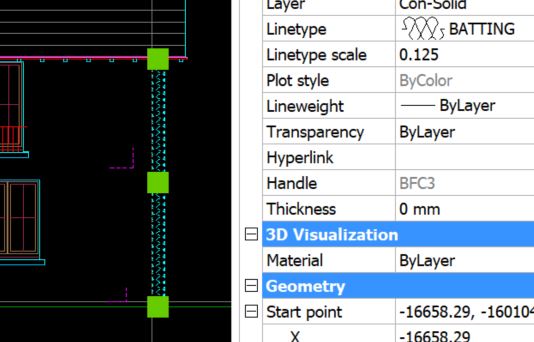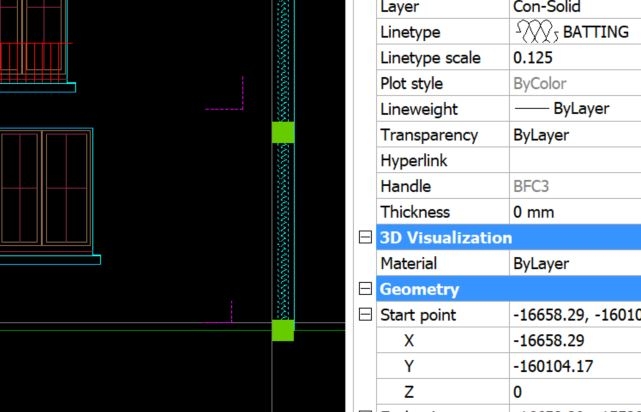Annotative Scale with linetypes?
Can Annotative Scale be used to make linetypes (e.g. dashed line) display at appropriate scale/spacing depending on Viewport scale?
Or does Annotative apply only to text, dims and hatches?
Comments
-
If The PSLTSCALE = ON, linetypes are scaled equally in paperspace viewports.
0 -
Thanks Louis, I think I've at last understood about MSLT, PSLT, and will use CANNO instead of LTSC for running-adjustment of linetype display scale in modelspace.
Except bloomin' BATTING linestyle, which I use a lot, but which goes wrong with every adjustment of CANNO. A pity BATTING lines can't be put on a special layer that can have Annotative turned off, similar to text, dimensions and hatches, so their width can be set relative to LTSCALE alone and will subsequently obey only Viewport scale.
Attached 100.jpg shows corner of building, which at 18m long is mainly viewed at around 1:100 scale in modelspace on-screen (unlike an 18mcm engineering part which would mostly be viewed at about 1:1). CANNO is therefore set to 1:100 in order that Linetypes be legible.
With CANNO set to 1:100, for 250mm thick BATTING (insulation) its LTSCALE is set to 0.5 x 200mm x CANNOSCALE = 0.5 x 250 x 1/100 = 0.125.Then I want to change CANNO to 1:50, for beter Linetype legibility, or even to 1:5 if I want to look at a detail of the building. 50.jpg shows what happens - the BATTING shrinks to half its proper width, and appears like that in Paperspace.
I wish BATTING (and a couple of other thickness-adjustable Linetypes) could be made immune to CANNOSCALE in modelspace, and be affected only by LTSCALE.

 0
0 -
Hello Tom,
you are absolutely right: Linetypes have always been considered 'annotational' (even before the so called feature appeared) - one of the many shortcomings of the way units are handled in dwg.
This means that using linetypes to depict real-world objects (insulation, center lines of streets etc.) is almost impossible.
For my own needs, I tried to tackle the problem together with the bigger one of having to deal with different units in model and paper space, for which support in dwg seems to be dwindling: Attached you find the drawing setup script that I am using, maybe you want to check this out.
I have the script autoloaded in my menu file, you would have to load it via appload (aec_init.lsp, the corresponding dcl-file has to be found in your search path).The script starts from the assumption that there are only two viable layout units: inches and millimeters, corresponding to the value of the MEASUREMENT variable. If not all related variables are set to reasonable values, it will launch a dialog that allows you to choose the scaling system (annotational or legacy) and also give you an option to enable real-world linetype scaling. This feature works in a way that all linetypes in the drawing with names prefixed with "ms-mm_" or "ms-in_" will be considered real-world linetypes, and will be scaled by a reactor to always display 1:1, no matter what LTSCALE or CANNOSCALEVALUE are set to.
At the moment, this means that you have to create a separate linetype for each real-world linetype that you need (e.g. each used thickness of batting insulation). I planned to enhance the system further by storing a real-world linetype scale in the respective object's xdata, but my time is limited, and it is not really pressing for me (duplicating linetype definitions with different scaling is not too hard).
Look at the little screen recording for what the script can do, but be warned that it cannot solve the problem completely: If you have such real-world scaled linetypes visible in several differently scaled mviews in a layout, scaling can only be correct in one (check out the attached example drawings) - I think this could only be addressed by Bricsys, but I doubt they will see the need to do so.
0 -
Wow thanks Knut - a lot there that's beyond me at present, but will study to understand. So there may be hope!
0 -
Cool! Thank you for sharing, Knut. I had given up on batting-type linetypes for the reason Tom described, and was resorting to lengths of batting pasted in as blocks, scaled to adjust thickness, and tediously xclipped as needed.
0

